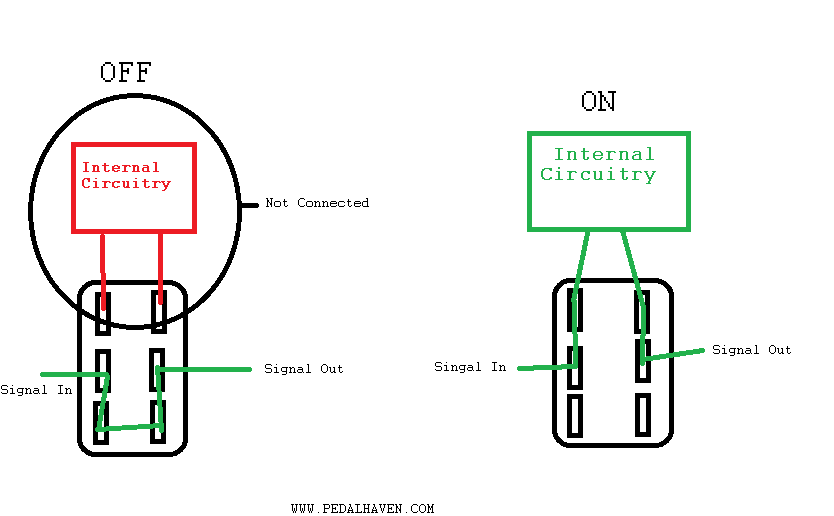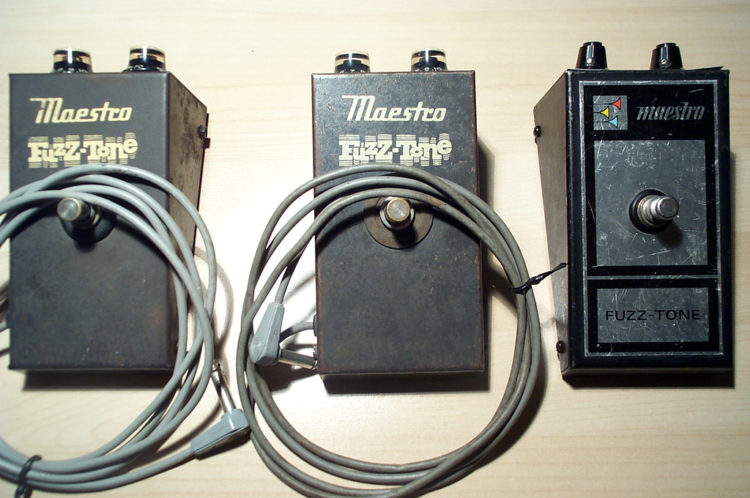This post may contain affiliate links
If you have ever shopped for guitar pedals or have researched how to make guitar pedals, you are sure to have come across some wild terms. Words like “Transparent” and “Stacking” are some of those that have an entirely different meanings in our little pedal world. However, there are two terms that are found in nearly every pedal description: “True Bypass” and “Buffered Bypass”. So what exactly do these terms mean?
What is True Bypass?
In the world of guitar pedals, “True Bypass” means that the mechanical side of your On/Off footswitch physically connects your input and output jacks when turned “off” – thus removing any other connections to the inner workings of the pedal (aside from the ground connection). This is meant to preserve your true guitar tone. In short, when a “True Bypass” pedal is turned off, your guitar signal does not pass through any of the components inside of the guitar pedal.
Here is a crudely drawn diagram I have created to help visualize what is happening:

What are the Benefits of True Bypass Pedals?
Tone! Ah yes. After all, aren’t we all on the quest for the perfect tone? As mentioned above, a true bypass pedal eliminates the guitar pedal’s internal circuitry when switched to the “off” position. In layman’s terms, turning the pedal off essentially removes it from your signal chain. This prevents the internal circuitry of the pedal from changing your tone at all when the pedal is turned off.
What are the Cons of True Bypass Pedals?
Newton’s Third Law states: For every action, there is an equal and opposite reaction. Who knew that Newton was such a pedal fanatic? All jokes aside, there is a downside to the true bypass pedal, and that is the notorious “popping” that may occur when switching the pedal on and off – which was notorious in older distortion and overdrive pedals.
Furthermore, another issue with true bypass pedals came with the rise of delay and reverb pedals. Since switching the pedal off completely removes the pedal from your signal chain – it completely removes your decaying reverb or delay trails. Which can put quite the damper on your washed-out, shoegaze-esque vibes.
In comes buffered bypass pedals.
What is Buffered Bypass?
A buffer is essentially a tiny pre-amp that helps enhance the signal passing through it, in this case, it works to help preserve your instrument’s tone. A pedal with a “buffered bypass” means that it has a buffer within its internal circuitry. Which, depending on the pedal, can be a highly sought-after feature.
What are the Benefits of Buffered Bypass?
Buffered bypass helps combat most of the issues that guitar players experienced with True Bypass, mentioned above. Alongside putting an end to the notorious “popping” issues and letting long delay and reverb trails soar (even after the pedal is turned off), buffered bypass also helps combat the problem of quality loss. Running a series of “True Bypass” pedals can act as using a very long instrument cable, yet every pedal-to-pedal connection has a chance to diminish your tone. Buffered bypass pedals help keep a strong signal from the start to the end of your pedal chain.
What are the Cons of Buffered Bypass Pedals?
Like most products, there is always a downside. In the Buffered Bypass world, the main issue is a poorly-built buffering design. A bad buffer can make the best sounding rig sound like a wounded bird being amplified through a tin can. Therefore, it is always a great idea to try out a pedal before you buy it!
So Should You Use True Bypass or Buffered Bypass Pedals?
The truth is, you should probably be using both. Most players have their own individual tastes and playing styles, which can be benefited by simply choosing the right features within your pedals. Typically you will see an assortment of both True Bypass and Buffered Bypass pedals on a pedalboard. However, these pros and cons should be considered when understanding how to set up a pedalboard.

